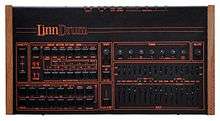LinnDrum
The LinnDrum is a drum machine manufactured by Linn Electronics between 1982 and 1985. About 5,000 units were sold.[1][2]
| LinnDrum | |
|---|---|
 LinnDrum digital drum machine | |
| Manufacturer | Linn Electronics |
| Dates | 1982–1985 |
| Price | US $2,995 |
| Technical specifications | |
| Polyphony | polyphonic 12 voices |
| Timbrality | multitimbral 15 voices |
| Synthesis type | 8-bit digital samples, 28–35 kHz |
| Storage memory | 56 user patterns, 42 preset drum patterns, 49 songs |
| Effects | Individual level and pan for all sounds, tuning for snare, tom and conga only |
| Input/output | |
| Keyboard | 15 hard plastic "pads" |
| External control | DIN sync (pre-MIDI), third-party MIDI Retrofit Kit, trigger inputs x5 |
Its high-quality samples, flexibility and affordability made the LinnDrum popular; it sold far more units than its predecessor (the LM-1) and its successor (the Linn 9000) combined.[2] Roger Linn re-used the moniker on the LinnDrum Midistudio and the Roger Linn Designs' LinnDrum II. The LinnDrum was used on many recordings throughout the 1980s, including international hits such as Frankie Goes to Hollywood's "Relax", a-Ha's "Take On Me", Harold Faltermeyer's "Axel F", Tears for Fears' "Shout", Deniece Williams's "Let's Hear it for the Boy", and Madonna's "Lucky Star".
When Linn Electronics closed in 1986, Forat Electronics purchased its assets[3] and offered service, sounds and modifications for the LinnDrum.[4] The LinnDrum was pre-MIDI, using a DIN sync interface,[5] but MIDI Retrofit Kits were offered by JL Cooper[6] and Forat Electronics.[4]
Features
The LinnDrum has fifteen 8-bit 28 kHz ~ 35 kHz digitally sampled drum sounds: bass drum, snare, side-stick snare, hi-hat, crash cymbal, ride cymbal, three tom-toms, cabasa, tambourine, high and low congas, cowbell, and hand-claps. Like the LM-1, it provided a sequencer for programming rhythm patterns, a built-in mixer and individual output jacks for each sound.
The LinnDrum improved on the LM-1 in many ways including: the addition of crash and ride cymbal samples, five external trigger inputs and the ability to replace built-in sounds with new sounds on EPROM chips. The LinnDrum sampled sounds from 28 to a 35 kHz sample rate. Also, the LinnDrum was $2,000 less than the LM-1. While on the LinnDrum only the snare and rimshot can be tuned together, and the tom and conga samples can be tuned separately. The Hi-Hats can also have the decay adjusted allowing for a wide range of uses. The LM-1, on the other hand, allows every sound to be individually tuned. Although, if a user desires more tuning capabilities, a third-party modification can be made to allow for everything to be tuned.
History
The LinnDrum was designed by Roger Linn. According to Linn, his company started out as a one-product company, depending on the success of the LM-1. He was inspired to design a successor after a NAMM show where he met Roland Corporation founder Ikutaro Kakehashi, who encouraged him to "move beyond being a one-product company so that a slowdown of my one product does not take the company down".[7]
Drum samples
According to some, the LinnDrum sounds were sampled from real drums played specifically for the machine by Los Angeles drummer Art Wood, a friend of Linn, who played with Linn and musicians including Peter Frampton, Gary Wright, Cher, Tina Turner, Bette Midler and James Brown.[8] However, "The LM-1 was the first drum machine to use samples of a real drum kit, Roger Linn confirms that it was indeed Art Wood session drummer that played the majority of the sounds that he used.[9] To further add to the mystery, an entry in the online museum of the Roger Linn Design company credits L.A. session drummer Art Wood with most of the samples."[1] While the Roger Linn Designs Past Products Museum page credits Art Wood for "most" of the LM-1 sounds, there is no credit for the drummer who played the sounds for the LinnDrum.
References
- "Linn Electronics LinnDrum at Vintage Synth Explorer". Retrieved 6 March 2015.
- Linn, Roger. "Past Products Museum". Roger Linn Designs. Retrieved 7 March 2015.
- "Then in 1986 Forat Electronics Corporation was born after purchasing Linn's remaining assets..." Forat Electronics - History.
- "Forat Electronics LinnDrum".
- Happy birthday MIDI 1.0: Slave to the rhythm, The Register
- "LINN LM-2 Drum Machine with JL Cooper Midi Mod & Instructions". MATRIXSYNTH. Retrieved 23 April 2015.
- Roger Linn, In Memory of Ikutaro Kakehashi, Roger Linn Design
- "Art Wood has full credit for programming the drum sounds for the Linn Drum Machine..." Linn Electronics LinnDrum at Vintage Synth Explorer. Retrieved 7 March 2015.
- Hey, what's that sound: Linn LM-1 Drum Computer and the Oberheim DMX by David McNamee The Guardian